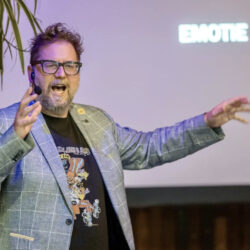Western passion

“Working hard for something we don’t care about is called stress; working hard for something we love is called passion,” is one of the many pertinent quotes by Simon Sinek, the renowned author and popular TED Talk speaker. Of course, the big question is whether you know what your passion is, what you’re prepared to work hard for and what the associated job precisely entails.
Adults often ask young children what they want to be when they grow up, which for most is impossible to answer. Back in high school, when I was 15 years old, I did a career test which revealed that I should become either a film director or a factory director.
The career advisor told me that careers in the film world were fairly unstable and so advised me to study business and become the director of a factory. After leaving school I did indeed study technical business administration before drifting into publishing and ending up writing about the world of supply chain and production directors.
But I’ve not neglected my passion for films in the meantime. Shortly after being advised to study business, I wrote a highly rated essay for my Dutch language exam about Sergio Leone, director of the well-known western movie Once Upon a Time in the West. In 2009 I heard film director Martin Koolhoven, who was known at that time for the Dutch film Oorlogswinter (Winter in Wartime), describe himself during a TV chat-show appearance as the Netherlands’ biggest fan of Sergio Leone. That prompted me to send him a letter refuting his claim but, unfortunately, Koolhoven didn’t write back to me.
Western thriller Brimstone
In 2011, however, during a Twitter discussion about realistic western comic books, I came into contact with Koolhoven after all. Not long afterwards he asked if I’d like to read his script for the western thriller Brimstone. At that time, he was still unsure of where to base the story. Since I’d visited many US national parks and western film locations myself, I had various ideas about where his movie could be set. During my research, I discovered that in the late 19th century there had been Dutch enclaves in the state of South Dakota, which would thus form the perfect basis for this Protestant western.
I used photos of the landscape and also some old photos of buildings to visualize the locations for the four distinct chapters in the film script. I also marked the locations in the Brimstone story on a geographical map of the US states to illustrate precisely where the action would be taking place, and using the Pinterest website I created various mood boards from photos and images to aid visualization.
Despite having a final budget of EUR12 million, Koolhoven couldn’t afford to film Brimstone in the US, which posed an extra challenge, so I embarked on a quest to find alternative film locations in Europe: Spain, Hungary, Romania, Germany, Sweden and the Alps. Ultimately, all my input resulted in a nice mention as a researcher in the film credits plus an invitation to the world premiere (and after-party) at the Venice Film Festival last September.
Visualization of complexity
It’s rewarding to have been able to do my bit towards this phenomenal western, with an international cast and the quality of Once Upon a Time in the West. Brimstone is already on general release in the Netherlands and some more European countries and will hit US cinemas later this year.
While conducting research for this film, I was once again reminded of the importance of visualization. At Supply Chain Media I make frequent use of visualization tools such as mindmaps and subway maps to make complex material more understandable, and I also utilize storytelling techniques to convey business messages effectively. The French film director Jean Luc Godard once summed up the power of storytelling beautifully when he said, “Sometimes reality is too complex. Stories give it form”.
The results of the career test I did over 30 years ago were actually not far wrong. I’ve managed to turn my company Supply Chain Media into a ‘paid hobby’ and I regard my work for Brimstone and any potential successors as an unpaid one (so far). They are both passions of mine, and I’m fortunate enough not to have to choose between the two.
Martijn Lofvers, publishing director & chief editor
martijn.lofvers@supplychainmedia.nl









